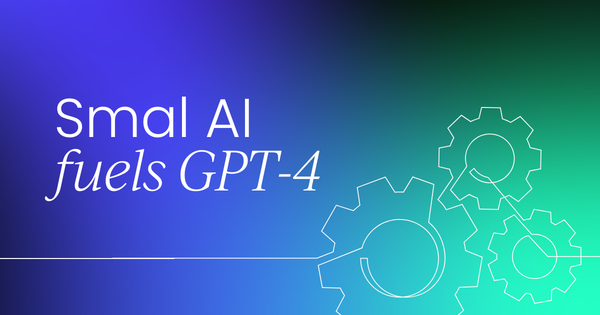A new framework called BeMyEyes shows how lightweight vision models can act as "eyes" for text-only AI systems, achieving better results than expensive multimodal models
The race to build ever-larger AI models might be taking an unexpected turn. Researchers from Microsoft, USC, and UC Davis have developed a clever workaround that lets text-only language models like GPT-4 and DeepSeek-R1 tackle visual tasks without expensive retraining. Their approach? Simply give these models a pair of "eyes."
The framework, called BeMyEyes, pairs small vision models with powerful text-only language models through natural conversation. Think of it as a highly sophisticated version of describing a photo to a friend over the phone.
The small vision model looks at images and describes what it sees, while the larger language model applies its reasoning skills to solve complex problems based on those descriptions.
What makes this particularly striking is the performance. When researchers equipped DeepSeek-R1 (a text-only model) with a modest 7-billion parameter vision model, it outperformed GPT-4o, OpenAI's state-of-the-art multimodal system, on several challenging benchmarks.
This wasn't supposed to happen. Conventional wisdom says you need massive, expensive multimodal models to excel at tasks combining vision and language.

The modular advantage changes everything
The traditional path to multimodal AI involves training enormous models that can process both text and images natively. This requires vast computational resources, specialized datasets, and often architectural overhauls. Companies like OpenAI and Google have invested heavily in this approach, producing impressive but costly systems.
BeMyEyes takes a radically different approach. Instead of creating one massive model that does everything, it orchestrates collaboration between specialized agents.
The perceiver agent (a small vision model) extracts visual information and describes it in detail. The reasoner agent (a powerful language model) interprets these descriptions and applies sophisticated reasoning to solve tasks.
This modularity offers several advantages:
- Cost efficiency: You only need to train or adapt small vision models for new tasks, not entire large language models
- Flexibility: As better language models become available, you can swap them in immediately without retraining
- Domain adaptation: Switching to specialized domains (like medical imaging) requires only changing the perceiver model
The researchers demonstrated this flexibility by swapping in a medical-specific vision model for healthcare tasks. Without any additional training of the reasoning model, the system immediately excelled at medical multimodal reasoning.
How conversation unlocks visual reasoning
The secret sauce lies in the multi-turn conversation between the two models. Rather than getting a single image description, the reasoning model can ask follow-up questions, request clarifications, and guide the perceiver to focus on specific visual details.
Here's how it works in practice. When faced with a complex visual question, the reasoner might ask:
"What exactly do you see in the upper right corner?" or "Can you describe the relationship between these two objects?"
The perceiver responds with detailed observations, and this back-and-forth continues until the reasoner has enough information to solve the problem.
This conversational approach mirrors how humans naturally collaborate when one person has access to information another needs. It's remarkably effective. The researchers found that restricting the system to single-turn interactions significantly hurt performance, highlighting the importance of this iterative refinement process.
Training perceivers to be better collaborators
Off-the-shelf vision models weren't quite ready for this collaborative role. They sometimes failed to provide sufficient detail or misunderstood their role in the conversation. To address this, the researchers developed a clever training pipeline.
They used GPT-4o to generate synthetic conversations, essentially having it roleplay both sides of the perceiver-reasoner dialogue. These conversations were then used to fine-tune smaller vision models specifically for collaboration. Importantly, this training didn't improve the vision models' standalone performance. Instead, it taught them to be better communicators and collaborators.
The training data consisted of about 12,000 multimodal questions paired with ideal conversations. This relatively modest dataset was enough to transform generic vision models into effective collaborative partners for language models.

Real implications for AI development
The success of BeMyEyes challenges several assumptions about how to build capable AI systems. First, it shows that bigger isn't always better. A well-orchestrated team of specialized models can outperform monolithic systems. Second, it demonstrates that we might not need to retrain massive models every time we want to add new capabilities.
For the open-source community, this is particularly exciting. While training GPT-4o-scale multimodal models remains out of reach for most organizations, building effective perceiver models is far more accessible. This democratizes access to cutting-edge multimodal AI capabilities.
The framework also suggests a path forward for extending AI to other modalities. Want to add audio understanding to a language model? Train a small audio perceiver. Need to process sensor data? Same approach. The modular design means each new modality becomes a relatively manageable engineering challenge rather than a massive research undertaking.
Looking ahead
BeMyEyes represents more than just a technical achievement. It's a philosophical shift in how we think about building AI systems. Rather than pursuing ever-larger monolithic models, we might achieve better results through clever orchestration of specialized components.
The researchers acknowledge some limitations. They've only tested the approach with vision so far, though the framework should generalize to other modalities. And while the system performs impressively, we don't know how it would compare to a hypothetical multimodal version of DeepSeek-R1 trained from scratch.
Still, the results are compelling enough to suggest that the future of AI might look more like a symphony of specialized models rather than a solo performance by a massive generalist.
As more powerful language models emerge, they can immediately gain multimodal capabilities through frameworks like BeMyEyes, without waiting for expensive multimodal versions to be developed.
For AI practitioners, the message is clear: sometimes the best solution isn't to build a bigger hammer. Sometimes you just need to teach your tools to work together.



 Follow us on LinkedIn
Follow us on LinkedIn




